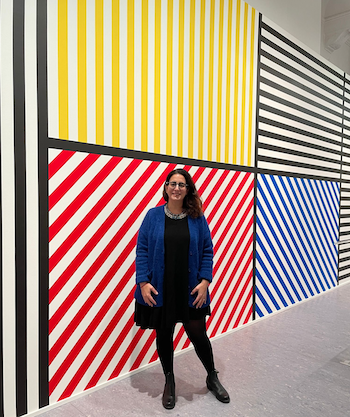When Stephanie Manasseh moved to Belgium with her then-husband some 21 years ago, she did not plan on becoming a staple of Brussels’ contemporary art world. It just happened.
“I saw that artists did not really have a chance to promote their own work,” she tells The Parliament. “The art fairs were reserved for galleries only. And I thought, why not just have an event where people can meet artists directly?”
Brussels is one of Europe’s contemporary art hubs, nowadays boasting over 40 private galleries and its own spot in the cultural calendar, with the Art Brussels fair taking place every Spring. Belgium, overall, has one of the highest rates of collectors per capita worldwide. Twenty years ago, it needed someone to bring the two together.
To give artists an opportunity to sell their work directly to an audience - rather than having to go through galleries, which usually take a 50 per cent commission to sell an artist’s work - Manasseh created the Accessible Art Fair. It ran for 15 editions, helping numerous artists, before coming to a stop during the pandemic.
Accessibility, here, has nothing to do with money. The fair’s goal was to “make the audience accessible to the artist, and the artist accessible to the audience,” as Manasseh explained in a New York Times panel in 2016.
Originally from Montreal, Manasseh is now an art consultant and curator, working on various projects through her own company, SM Art Advisory. On a recent Autumn morning, over coffee in her Brussels home, we spoke about the art market’s past, present and future.
Here are excerpts of that conversation, edited for clarity.
How has the art market changed in the past twenty years?
I think attitudes towards buying directly from artists have changed. In the old days, when I started the art fair, there was no social media. People really had to do their own marketing, and it was the galleries that were putting forward the artists. So the Art Fair was a chance for people to meet the artists directly and to buy from them directly. With the advent of social media, artists do their own promotion - and regularly. It's not strange now to buy directly from the artists, and it's not new and different.
It’s very interesting to me that you did not specifically come to Belgium hoping to work in the arts here.
Exactly. When I moved here I saw that there was an opening, because people were very interested in art. And I saw that people wanted to engage. But there were no opportunities for regular people who were interested in art. I wanted to have something where people can engage with artists directly, and show a certain quality of art - which is why the fair worked with a jury to ensure the quality of the work shown.
At the time, you were referred to as a disruptor, or an innovator, thanks to your model of foregoing galleries and showing art directly from the artists.
There was a bit of hesitancy, especially from the Belgian population, to engage in this kind of event, because they were so used to the model where the artists are never seen. But we won their hearts over, in time. I’ve seen this model replicated several times since.
 Manasseh at a show of American artist Sol LeWitt's work, which she curated
Manasseh at a show of American artist Sol LeWitt's work, which she curated
How would you find the artists you featured?
At the beginning, I was reaching out to them. I’d go to openings, take studio tours and so on. As we became more known in the art scene, we’d put out calls for artists and artists were really looking forward to that time that they could apply. It became a really nice competition for artists to attend the fair.
Was there something about Belgium that made it the right place for this project to evolve as it did?
There's a unique factor here: there's such a huge expat community. They were my first target audience, to start with. And as I started to develop my reputation amongst Belgians, I realized there are a lot of art collectors here. [Some of Europe’s] biggest art collectors are living in Belgium. I think there's a trickle down effect because other Belgians want to aspire to that as well.
How do you see the future of the market in Europe?
The big art fairs are now moving to Paris. The UK is a bit tough now, with taxes and shipping - I think they’re going to take a real hit, if they haven’t already. Outside of Belgium, Brussels is seen as an important art city. It’s not a hub like Paris is, but we have a lot going on here and a lot of collectors.
What kind of projects do you work on through your company?
I started SM Art Advisory at the same time as the fair, as a way for people to contact me outside of the fair, to help them source art. People tell me their budgets and what they want, and I help them find art. So we advise, we work on projects and events, anything to do with art really. That’s how I got to work on a project near Paris, for example, a big outdoor sculpture installation near Disneyland this summer.
And what about the fair? What happens now?
I’m ready now to announce that I’ve put it to sleep. We had 15 wonderful years. We engaged with hundreds, if not thousands of artists. I tried to revive it after the pandemic, but it has run its course.
Sign up to The Parliament's weekly newsletter
Every Friday our editorial team goes behind the headlines to offer insight and analysis on the key stories driving the EU agenda. Subscribe for free here.